stop start FIAT PANDA 2018 Owner handbook (in English)
[x] Cancel search | Manufacturer: FIAT, Model Year: 2018, Model line: PANDA, Model: FIAT PANDA 2018Pages: 228, PDF Size: 17.05 MB
Page 53 of 228
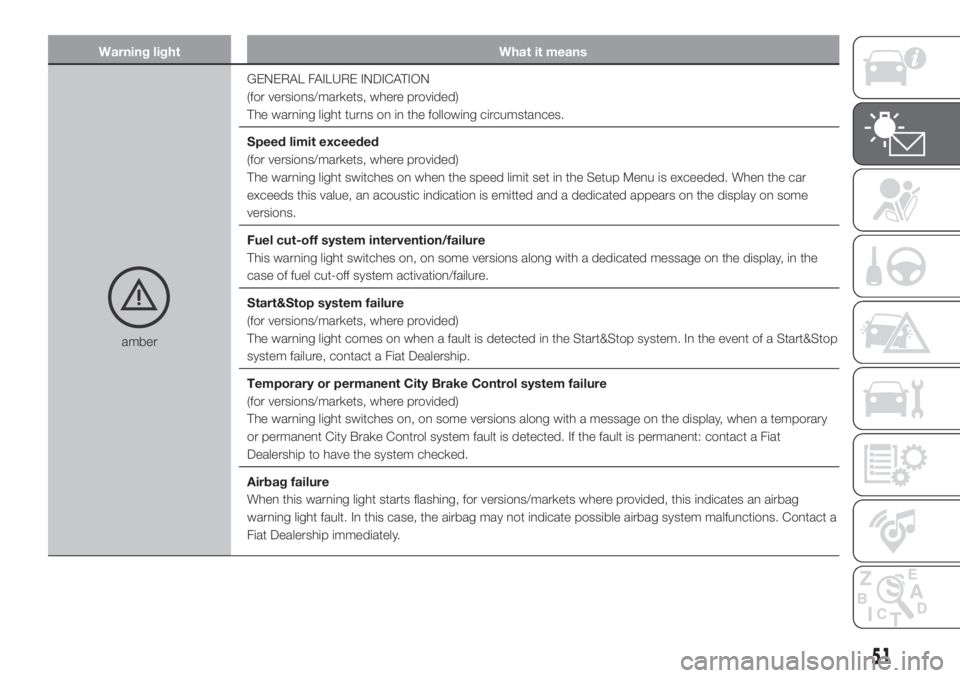
Warning light What it means
amberGENERAL FAILURE INDICATION
(for versions/markets, where provided)
The warning light turns on in the following circumstances.
Speed limit exceeded
(for versions/markets, where provided)
The warning light switches on when the speed limit set in the Setup Menu is exceeded. When the car
exceeds this value, an acoustic indication is emitted and a dedicated appears on the display on some
versions.
Fuel cut-off system intervention/failure
This warning light switches on, on some versions along with a dedicated message on the display, in the
case of fuel cut-off system activation/failure.
Start&Stop system failure
(for versions/markets, where provided)
The warning light comes on when a fault is detected in the Start&Stop system. In the event of a Start&Stop
system failure, contact a Fiat Dealership.
Temporary or permanent City Brake Control system failure
(for versions/markets, where provided)
The warning light switches on, on some versions along with a message on the display, when a temporary
or permanent City Brake Control system fault is detected. If the fault is permanent: contact a Fiat
Dealership to have the system checked.
Airbag failure
When this warning light starts flashing, for versions/markets where provided, this indicates an airbag
warning light fault. In this case, the airbag may not indicate possible airbag system malfunctions. Contact a
Fiat Dealership immediately.
51
Page 59 of 228
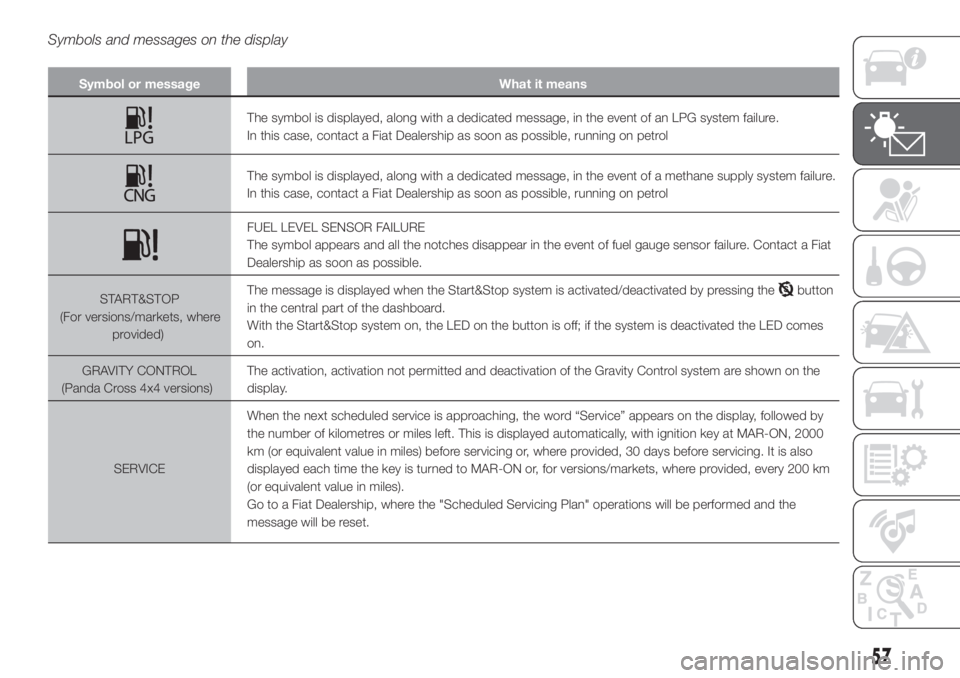
Symbols and messages on the display
Symbol or message What it means
The symbol is displayed, along with a dedicated message, in the event of an LPG system failure.
In this case, contact a Fiat Dealership as soon as possible, running on petrol
The symbol is displayed, along with a dedicated message, in the event of a methane supply system failure.
In this case, contact a Fiat Dealership as soon as possible, running on petrol
FUEL LEVEL SENSOR FAILURE
The symbol appears and all the notches disappear in the event of fuel gauge sensor failure. Contact a Fiat
Dealership as soon as possible.
START&STOP
(For versions/markets, where
provided)The message is displayed when the Start&Stop system is activated/deactivated by pressing the
button
in the central part of the dashboard.
With the Start&Stop system on, the LED on the button is off; if the system is deactivated the LED comes
on.
GRAVITY CONTROL
(Panda Cross 4x4 versions)The activation, activation not permitted and deactivation of the Gravity Control system are shown on the
display.
SERVICEWhen the next scheduled service is approaching, the word “Service” appears on the display, followed by
the number of kilometres or miles left. This is displayed automatically, with ignition key at MAR-ON, 2000
km (or equivalent value in miles) before servicing or, where provided, 30 days before servicing. It is also
displayed each time the key is turned to MAR-ON or, for versions/markets, where provided, every 200 km
(or equivalent value in miles).
Go to a Fiat Dealership, where the "Scheduled Servicing Plan" operations will be performed and the
message will be reset.
57
Page 66 of 228
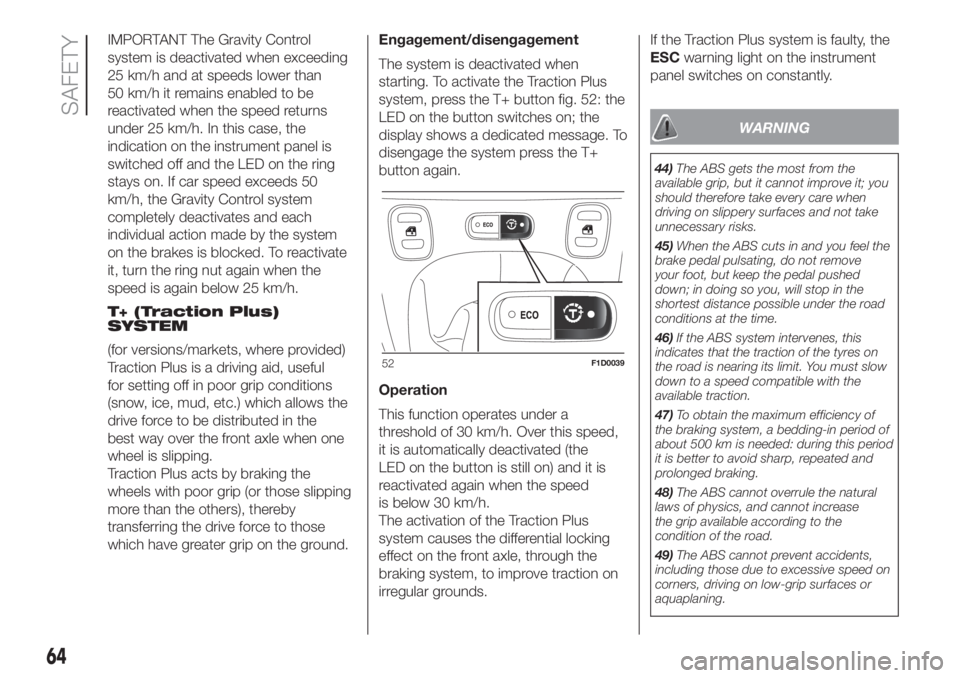
IMPORTANT The Gravity Control
system is deactivated when exceeding
25 km/h and at speeds lower than
50 km/h it remains enabled to be
reactivated when the speed returns
under 25 km/h. In this case, the
indication on the instrument panel is
switched off and the LED on the ring
stays on. If car speed exceeds 50
km/h, the Gravity Control system
completely deactivates and each
individual action made by the system
on the brakes is blocked. To reactivate
it, turn the ring nut again when the
speed is again below 25 km/h.
T+ (Traction Plus)
SYSTEM
(for versions/markets, where provided)
Traction Plus is a driving aid, useful
for setting off in poor grip conditions
(snow, ice, mud, etc.) which allows the
drive force to be distributed in the
best way over the front axle when one
wheel is slipping.
Traction Plus acts by braking the
wheels with poor grip (or those slipping
more than the others), thereby
transferring the drive force to those
which have greater grip on the ground.Engagement/disengagement
The system is deactivated when
starting. To activate the Traction Plus
system, press the T+ button fig. 52: the
LED on the button switches on; the
display shows a dedicated message. To
disengage the system press the T+
button again.
Operation
This function operates under a
threshold of 30 km/h. Over this speed,
it is automatically deactivated (the
LED on the button is still on) and it is
reactivated again when the speed
is below 30 km/h.
The activation of the Traction Plus
system causes the differential locking
effect on the front axle, through the
braking system, to improve traction on
irregular grounds.If the Traction Plus system is faulty, the
ESCwarning light on the instrument
panel switches on constantly.
WARNING
44)The ABS gets the most from the
available grip, but it cannot improve it; you
should therefore take every care when
driving on slippery surfaces and not take
unnecessary risks.
45)When the ABS cuts in and you feel the
brake pedal pulsating, do not remove
your foot, but keep the pedal pushed
down; in doing so you, will stop in the
shortest distance possible under the road
conditions at the time.
46)If the ABS system intervenes, this
indicates that the traction of the tyres on
the road is nearing its limit. You must slow
down to a speed compatible with the
available traction.
47)To obtain the maximum efficiency of
the braking system, a bedding-in period of
about 500 km is needed: during this period
it is better to avoid sharp, repeated and
prolonged braking.
48)The ABS cannot overrule the natural
laws of physics, and cannot increase
the grip available according to the
condition of the road.
49)The ABS cannot prevent accidents,
including those due to excessive speed on
corners, driving on low-grip surfaces or
aquaplaning.
52F1D0039
64
SAFETY
Page 68 of 228
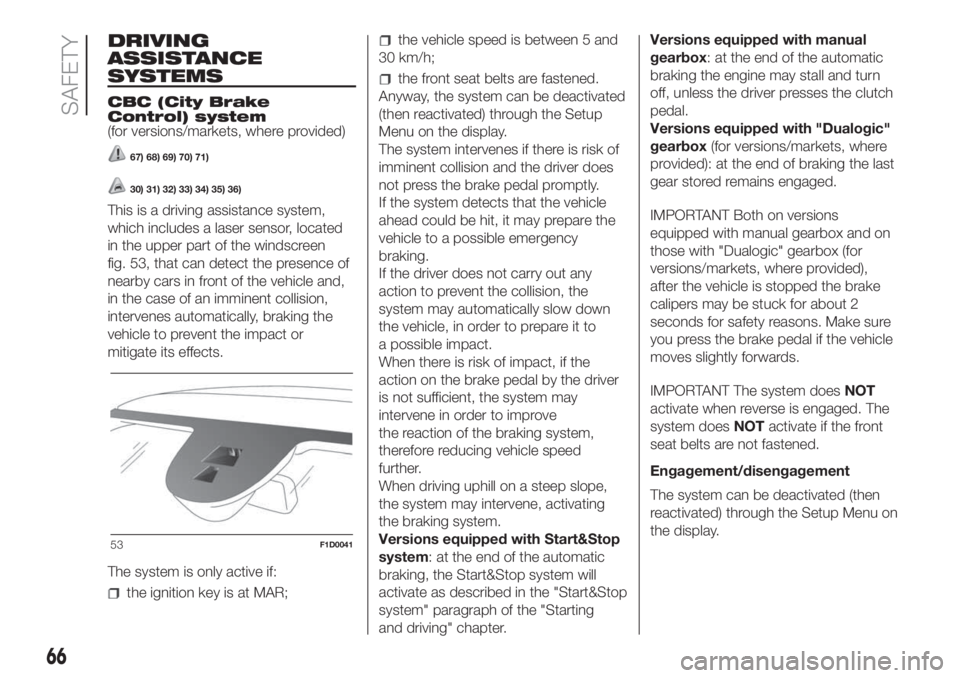
DRIVING
ASSISTANCE
SYSTEMS
CBC (City Brake
Control) system
(for versions/markets, where provided)
67) 68) 69) 70) 71)
30) 31) 32) 33) 34) 35) 36)
This is a driving assistance system,
which includes a laser sensor, located
in the upper part of the windscreen
fig. 53, that can detect the presence of
nearby cars in front of the vehicle and,
in the case of an imminent collision,
intervenes automatically, braking the
vehicle to prevent the impact or
mitigate its effects.
The system is only active if:
the ignition key is at MAR;
the vehicle speed is between 5 and
30 km/h;
the front seat belts are fastened.
Anyway, the system can be deactivated
(then reactivated) through the Setup
Menu on the display.
The system intervenes if there is risk of
imminent collision and the driver does
not press the brake pedal promptly.
If the system detects that the vehicle
ahead could be hit, it may prepare the
vehicle to a possible emergency
braking.
If the driver does not carry out any
action to prevent the collision, the
system may automatically slow down
the vehicle, in order to prepare it to
a possible impact.
When there is risk of impact, if the
action on the brake pedal by the driver
is not sufficient, the system may
intervene in order to improve
the reaction of the braking system,
therefore reducing vehicle speed
further.
When driving uphill on a steep slope,
the system may intervene, activating
the braking system.
Versions equipped with Start&Stop
system: at the end of the automatic
braking, the Start&Stop system will
activate as described in the "Start&Stop
system" paragraph of the "Starting
and driving" chapter.Versions equipped with manual
gearbox: at the end of the automatic
braking the engine may stall and turn
off, unless the driver presses the clutch
pedal.
Versions equipped with "Dualogic"
gearbox(for versions/markets, where
provided): at the end of braking the last
gear stored remains engaged.
IMPORTANT Both on versions
equipped with manual gearbox and on
those with "Dualogic" gearbox (for
versions/markets, where provided),
after the vehicle is stopped the brake
calipers may be stuck for about 2
seconds for safety reasons. Make sure
you press the brake pedal if the vehicle
moves slightly forwards.
IMPORTANT The system doesNOT
activate when reverse is engaged. The
system doesNOTactivate if the front
seat belts are not fastened.
Engagement/disengagement
The system can be deactivated (then
reactivated) through the Setup Menu on
the display.
53F1D0041
66
SAFETY
Page 70 of 228
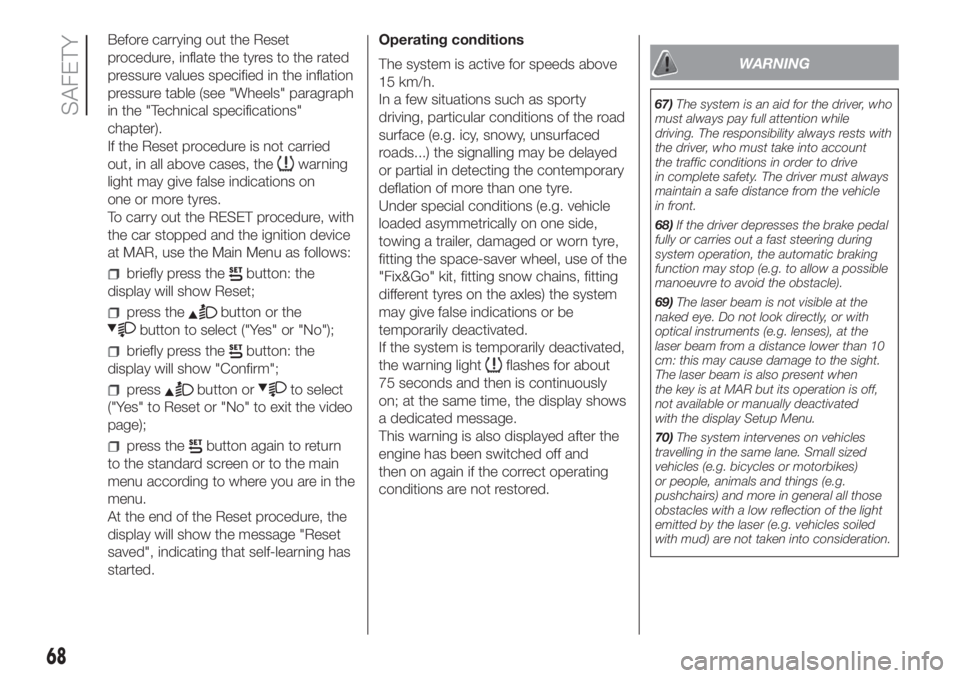
Before carrying out the Reset
procedure, inflate the tyres to the rated
pressure values specified in the inflation
pressure table (see "Wheels" paragraph
in the "Technical specifications"
chapter).
If the Reset procedure is not carried
out, in all above cases, the
warning
light may give false indications on
one or more tyres.
To carry out the RESET procedure, with
the car stopped and the ignition device
at MAR, use the Main Menu as follows:
briefly press thebutton: the
display will show Reset;
press thebutton or the
button to select ("Yes" or "No");
briefly press thebutton: the
display will show "Confirm";
pressbutton orto select
("Yes" to Reset or "No" to exit the video
page);
press thebutton again to return
to the standard screen or to the main
menu according to where you are in the
menu.
At the end of the Reset procedure, the
display will show the message "Reset
saved", indicating that self-learning has
started.Operating conditions
The system is active for speeds above
15 km/h.
In a few situations such as sporty
driving, particular conditions of the road
surface (e.g. icy, snowy, unsurfaced
roads...) the signalling may be delayed
or partial in detecting the contemporary
deflation of more than one tyre.
Under special conditions (e.g. vehicle
loaded asymmetrically on one side,
towing a trailer, damaged or worn tyre,
fitting the space-saver wheel, use of the
"Fix&Go" kit, fitting snow chains, fitting
different tyres on the axles) the system
may give false indications or be
temporarily deactivated.
If the system is temporarily deactivated,
the warning light
flashes for about
75 seconds and then is continuously
on; at the same time, the display shows
a dedicated message.
This warning is also displayed after the
engine has been switched off and
then on again if the correct operating
conditions are not restored.
WARNING
67)The system is an aid for the driver, who
must always pay full attention while
driving. The responsibility always rests with
the driver, who must take into account
the traffic conditions in order to drive
in complete safety. The driver must always
maintain a safe distance from the vehicle
in front.
68)If the driver depresses the brake pedal
fully or carries out a fast steering during
system operation, the automatic braking
function may stop (e.g. to allow a possible
manoeuvre to avoid the obstacle).
69)The laser beam is not visible at the
naked eye. Do not look directly, or with
optical instruments (e.g. lenses), at the
laser beam from a distance lower than 10
cm: this may cause damage to the sight.
The laser beam is also present when
the key is at MAR but its operation is off,
not available or manually deactivated
with the display Setup Menu.
70)The system intervenes on vehicles
travelling in the same lane. Small sized
vehicles (e.g. bicycles or motorbikes)
or people, animals and things (e.g.
pushchairs) and more in general all those
obstacles with a low reflection of the light
emitted by the laser (e.g. vehicles soiled
with mud) are not taken into consideration.
68
SAFETY
Page 71 of 228
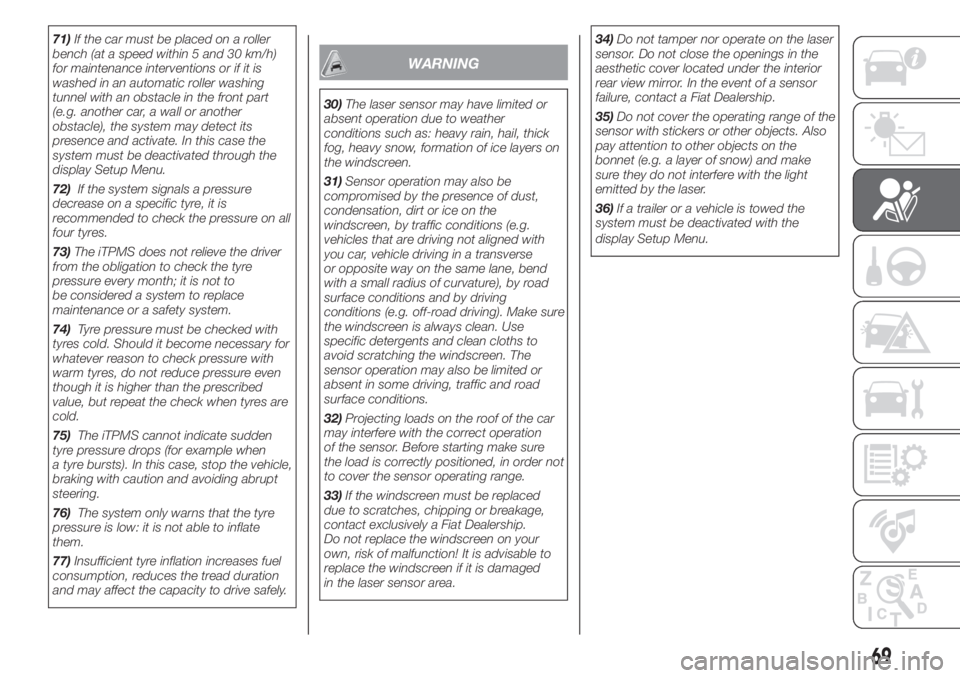
71)If the car must be placed on a roller
bench (at a speed within 5 and 30 km/h)
for maintenance interventions or if it is
washed in an automatic roller washing
tunnel with an obstacle in the front part
(e.g. another car, a wall or another
obstacle), the system may detect its
presence and activate. In this case the
system must be deactivated through the
display Setup Menu.
72)If the system signals a pressure
decrease on a specific tyre, it is
recommended to check the pressure on all
four tyres.
73)The iTPMS does not relieve the driver
from the obligation to check the tyre
pressure every month; it is not to
be considered a system to replace
maintenance or a safety system.
74)Tyre pressure must be checked with
tyres cold. Should it become necessary for
whatever reason to check pressure with
warm tyres, do not reduce pressure even
though it is higher than the prescribed
value, but repeat the check when tyres are
cold.
75)The iTPMS cannot indicate sudden
tyre pressure drops (for example when
a tyre bursts). In this case, stop the vehicle,
braking with caution and avoiding abrupt
steering.
76)The system only warns that the tyre
pressure is low: it is not able to inflate
them.
77)Insufficient tyre inflation increases fuel
consumption, reduces the tread duration
and may affect the capacity to drive safely.
WARNING
30)The laser sensor may have limited or
absent operation due to weather
conditions such as: heavy rain, hail, thick
fog, heavy snow, formation of ice layers on
the windscreen.
31)Sensor operation may also be
compromised by the presence of dust,
condensation, dirt or ice on the
windscreen, by traffic conditions (e.g.
vehicles that are driving not aligned with
you car, vehicle driving in a transverse
or opposite way on the same lane, bend
with a small radius of curvature), by road
surface conditions and by driving
conditions (e.g. off-road driving). Make sure
the windscreen is always clean. Use
specific detergents and clean cloths to
avoid scratching the windscreen. The
sensor operation may also be limited or
absent in some driving, traffic and road
surface conditions.
32)Projecting loads on the roof of the car
may interfere with the correct operation
of the sensor. Before starting make sure
the load is correctly positioned, in order not
to cover the sensor operating range.
33)If the windscreen must be replaced
due to scratches, chipping or breakage,
contact exclusively a Fiat Dealership.
Do not replace the windscreen on your
own, risk of malfunction! It is advisable to
replace the windscreen if it is damaged
in the laser sensor area.34)Do not tamper nor operate on the laser
sensor. Do not close the openings in the
aesthetic cover located under the interior
rear view mirror. In the event of a sensor
failure, contact a Fiat Dealership.
35)Do not cover the operating range of the
sensor with stickers or other objects. Also
pay attention to other objects on the
bonnet (e.g. a layer of snow) and make
sure they do not interfere with the light
emitted by the laser.
36)If a trailer or a vehicle is towed the
system must be deactivated with the
display Setup Menu.
69
Page 74 of 228
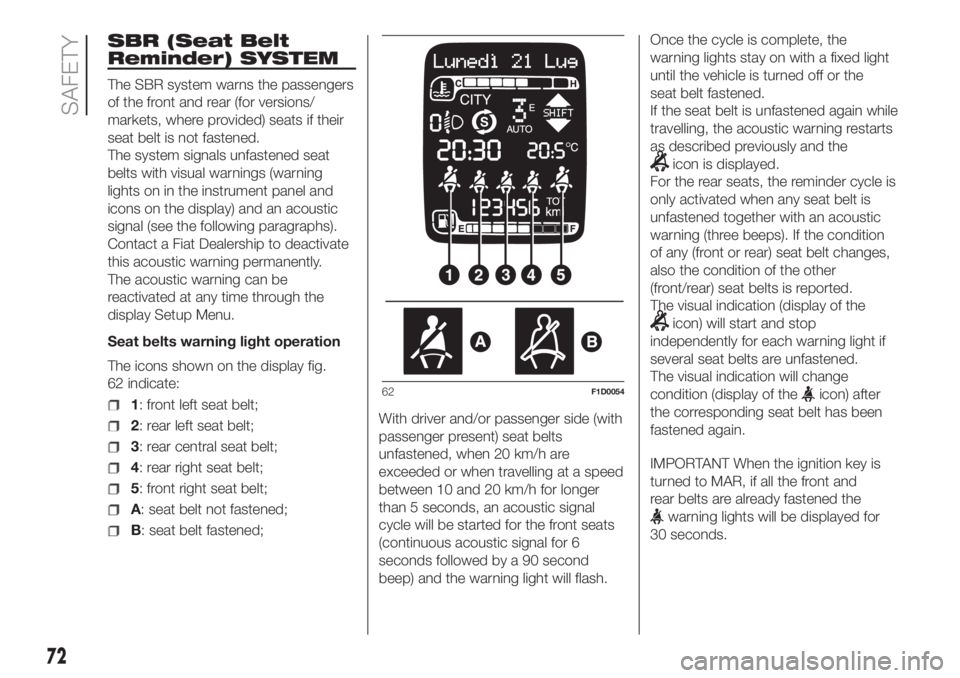
SBR (Seat Belt
Reminder) SYSTEM
The SBR system warns the passengers
of the front and rear (for versions/
markets, where provided) seats if their
seat belt is not fastened.
The system signals unfastened seat
belts with visual warnings (warning
lights on in the instrument panel and
icons on the display) and an acoustic
signal (see the following paragraphs).
Contact a Fiat Dealership to deactivate
this acoustic warning permanently.
The acoustic warning can be
reactivated at any time through the
display Setup Menu.
Seat belts warning light operation
The icons shown on the display fig.
62 indicate:
1: front left seat belt;
2: rear left seat belt;
3: rear central seat belt;
4: rear right seat belt;
5: front right seat belt;
A: seat belt not fastened;
B: seat belt fastened;With driver and/or passenger side (with
passenger present) seat belts
unfastened, when 20 km/h are
exceeded or when travelling at a speed
between 10 and 20 km/h for longer
than 5 seconds, an acoustic signal
cycle will be started for the front seats
(continuous acoustic signal for 6
seconds followed by a 90 second
beep) and the warning light will flash.Once the cycle is complete, the
warning lights stay on with a fixed light
until the vehicle is turned off or the
seat belt fastened.
If the seat belt is unfastened again while
travelling, the acoustic warning restarts
as described previously and the
icon is displayed.
For the rear seats, the reminder cycle is
only activated when any seat belt is
unfastened together with an acoustic
warning (three beeps). If the condition
of any (front or rear) seat belt changes,
also the condition of the other
(front/rear) seat belts is reported.
The visual indication (display of the
icon) will start and stop
independently for each warning light if
several seat belts are unfastened.
The visual indication will change
condition (display of the
icon) after
the corresponding seat belt has been
fastened again.
IMPORTANT When the ignition key is
turned to MAR, if all the front and
rear belts are already fastened the
warning lights will be displayed for
30 seconds.
62F1D0054
72
SAFETY
Page 93 of 228
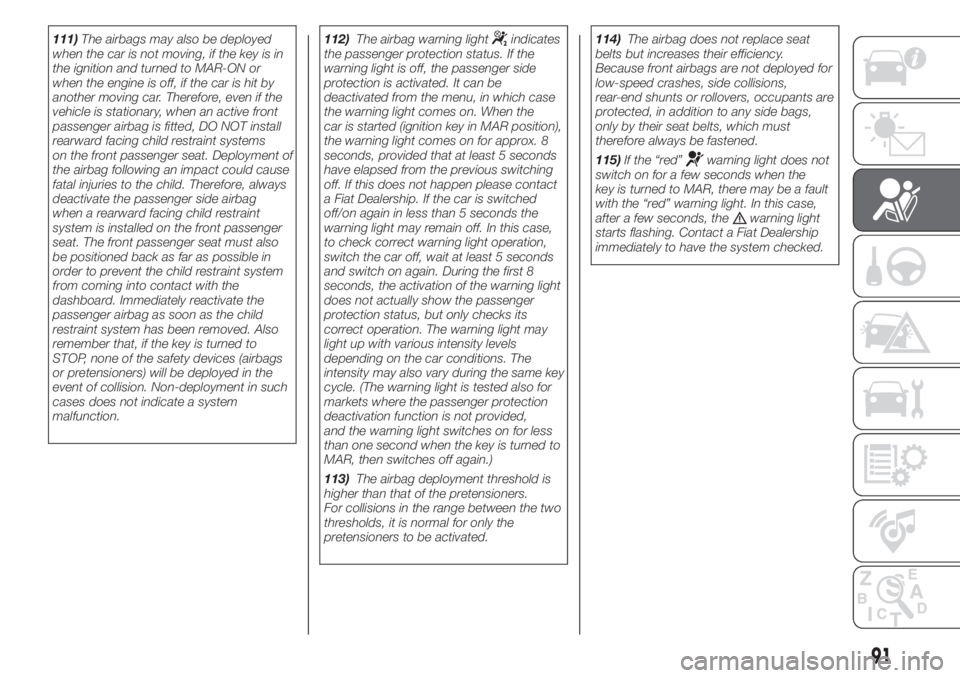
111)The airbags may also be deployed
when the car is not moving, if the key is in
the ignition and turned to MAR-ON or
when the engine is off, if the car is hit by
another moving car. Therefore, even if the
vehicle is stationary, when an active front
passenger airbag is fitted, DO NOT install
rearward facing child restraint systems
on the front passenger seat. Deployment of
the airbag following an impact could cause
fatal injuries to the child. Therefore, always
deactivate the passenger side airbag
when a rearward facing child restraint
system is installed on the front passenger
seat. The front passenger seat must also
be positioned back as far as possible in
order to prevent the child restraint system
from coming into contact with the
dashboard. Immediately reactivate the
passenger airbag as soon as the child
restraint system has been removed. Also
remember that, if the key is turned to
STOP, none of the safety devices (airbags
or pretensioners) will be deployed in the
event of collision. Non-deployment in such
cases does not indicate a system
malfunction.112)The airbag warning lightindicates
the passenger protection status. If the
warning light is off, the passenger side
protection is activated. It can be
deactivated from the menu, in which case
the warning light comes on. When the
car is started (ignition key in MAR position),
the warning light comes on for approx. 8
seconds, provided that at least 5 seconds
have elapsed from the previous switching
off. If this does not happen please contact
a Fiat Dealership. If the car is switched
off/on again in less than 5 seconds the
warning light may remain off. In this case,
to check correct warning light operation,
switch the car off, wait at least 5 seconds
and switch on again. During the first 8
seconds, the activation of the warning light
does not actually show the passenger
protection status, but only checks its
correct operation. The warning light may
light up with various intensity levels
depending on the car conditions. The
intensity may also vary during the same key
cycle. (The warning light is tested also for
markets where the passenger protection
deactivation function is not provided,
and the warning light switches on for less
than one second when the key is turned to
MAR, then switches off again.)
113)The airbag deployment threshold is
higher than that of the pretensioners.
For collisions in the range between the two
thresholds, it is normal for only the
pretensioners to be activated.114)The airbag does not replace seat
belts but increases their efficiency.
Because front airbags are not deployed for
low-speed crashes, side collisions,
rear-end shunts or rollovers, occupants are
protected, in addition to any side bags,
only by their seat belts, which must
therefore always be fastened.
115)If the “red”
warning light does not
switch on for a few seconds when the
key is turned to MAR, there may be a fault
with the “red” warning light. In this case,
after a few seconds, the
warning light
starts flashing. Contact a Fiat Dealership
immediately to have the system checked.
91
Page 94 of 228
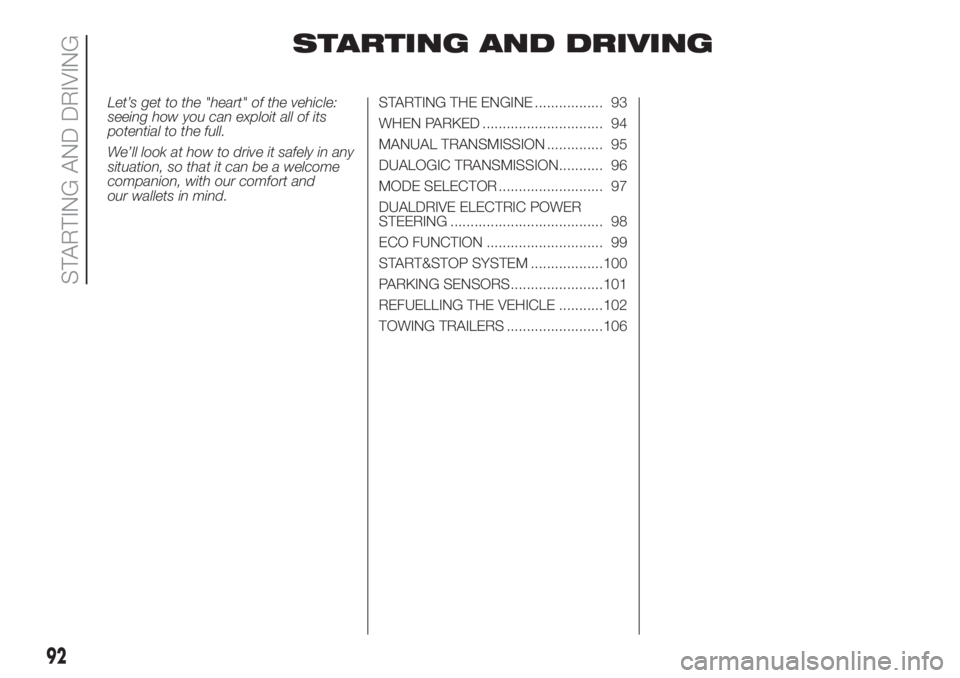
STARTING AND DRIVING
Let’s get to the "heart" of the vehicle:
seeing how you can exploit all of its
potential to the full.
We’ll look at how to drive it safely in any
situation, so that it can be a welcome
companion, with our comfort and
our wallets in mind.STARTING THE ENGINE ................. 93
WHEN PARKED .............................. 94
MANUAL TRANSMISSION .............. 95
DUALOGIC TRANSMISSION........... 96
MODE SELECTOR .......................... 97
DUALDRIVE ELECTRIC POWER
STEERING ...................................... 98
ECO FUNCTION ............................. 99
START&STOP SYSTEM ..................100
PARKING SENSORS.......................101
REFUELLING THE VEHICLE ...........102
TOWING TRAILERS ........................106
92
STARTING AND DRIVING
Page 95 of 228
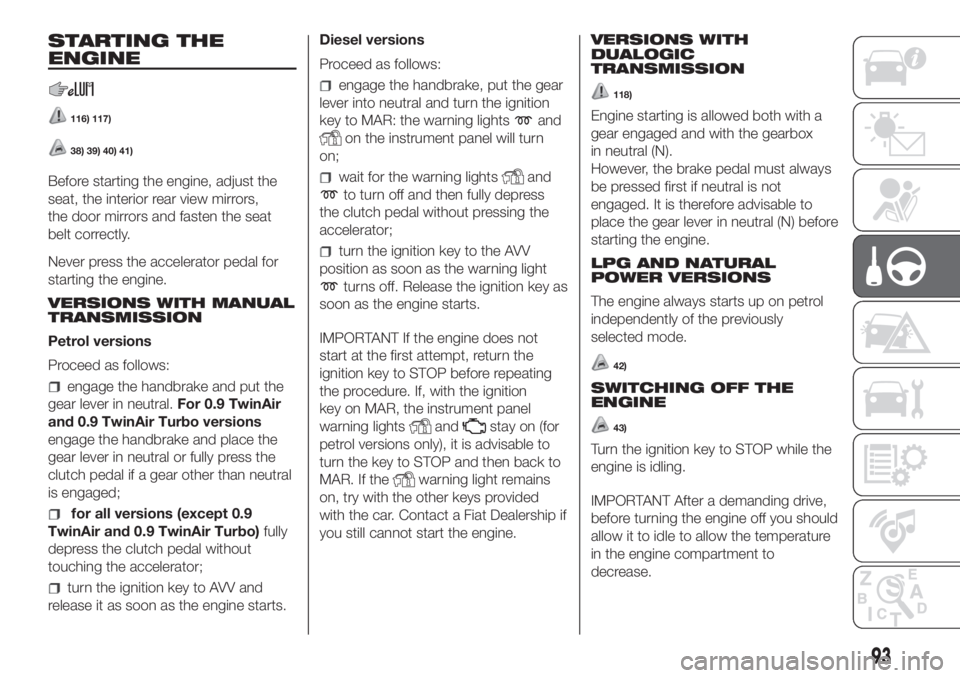
STARTING THE
ENGINE
116) 117)
38) 39) 40) 41)
Before starting the engine, adjust the
seat, the interior rear view mirrors,
the door mirrors and fasten the seat
belt correctly.
Never press the accelerator pedal for
starting the engine.
VERSIONS WITH MANUAL
TRANSMISSION
Petrol versions
Proceed as follows:
engage the handbrake and put the
gear lever in neutral.For 0.9 TwinAir
and 0.9 TwinAir Turbo versions
engage the handbrake and place the
gear lever in neutral or fully press the
clutch pedal if a gear other than neutral
is engaged;
for all versions (except 0.9
TwinAir and 0.9 TwinAir Turbo)fully
depress the clutch pedal without
touching the accelerator;
turn the ignition key to AVV and
release it as soon as the engine starts.Diesel versions
Proceed as follows:
engage the handbrake, put the gear
lever into neutral and turn the ignition
key to MAR: the warning lights
and
on the instrument panel will turn
on;
wait for the warning lightsand
to turn off and then fully depress
the clutch pedal without pressing the
accelerator;
turn the ignition key to the AVV
position as soon as the warning light
turns off. Release the ignition key as
soon as the engine starts.
IMPORTANT If the engine does not
start at the first attempt, return the
ignition key to STOP before repeating
the procedure. If, with the ignition
key on MAR, the instrument panel
warning lights
andstay on (for
petrol versions only), it is advisable to
turn the key to STOP and then back to
MAR. If the
warning light remains
on, try with the other keys provided
with the car. Contact a Fiat Dealership if
you still cannot start the engine.VERSIONS WITH
DUALOGIC
TRANSMISSION
118)
Engine starting is allowed both with a
gear engaged and with the gearbox
in neutral (N).
However, the brake pedal must always
be pressed first if neutral is not
engaged. It is therefore advisable to
place the gear lever in neutral (N) before
starting the engine.
LPG AND NATURAL
POWER VERSIONS
The engine always starts up on petrol
independently of the previously
selected mode.
42)
SWITCHING OFF THE
ENGINE
43)
Turn the ignition key to STOP while the
engine is idling.
IMPORTANT After a demanding drive,
before turning the engine off you should
allow it to idle to allow the temperature
in the engine compartment to
decrease.
93